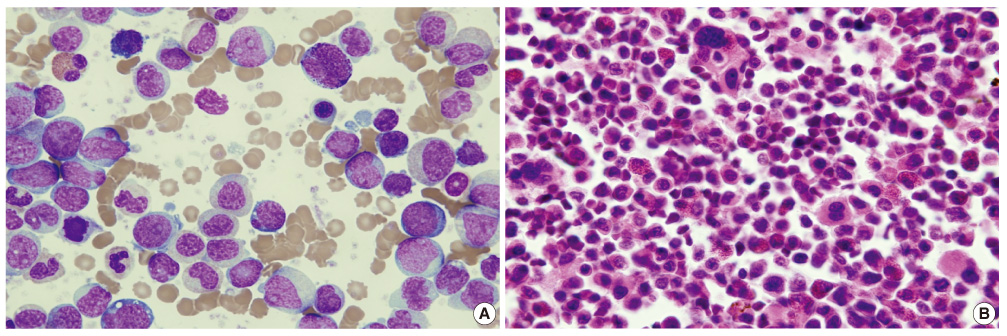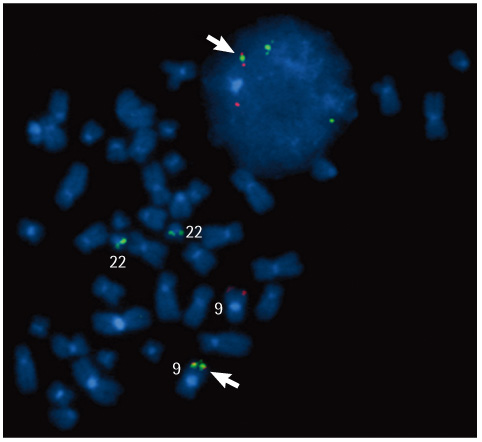Lab Med Online.
2011 Jul;1(3):163-167.
A Case of Concomitant Inv(3)(q21q26) and Cryptic BCR/ABL1 Rearrangement in the Blast Crisis of Chronic Myeloid Leukemia
- Affiliations
-
- 1Department of Laboratory Medicine, College of Medicine, Korea University, Seoul, Korea. yuret@korea.ac.kr
Abstract
- Structural abnormalities of the long arm of chromosome 3 (3q) have been associated with elevated platelet count and hyperplasia of megakaryocytes with dysplasia in various hematological malignancies. Some cases of chronic myeloid leukemia (CML) may acquire inv(3) (q21q26) or t(3;3)(q21;q26), and such a finding usually indicates accelerated or blast phase of their disease. We report a case of concomitant inv(3) (q21q26) and cryptic BCR/ABL1 rearrangement in the blast crisis of CML. The patient was 17-year-old male and showed marked leukocytosis and thrombocytosis at admission. Leukocyte differentials showed eosinophilia, basophilia and increased blasts. The bone marrow was hypercellular with granulocytic hyperplasia, and dysmorphic megakaryocytes were frequently observed. Conventional cytogenetic analysis revealed only an inv(3)(q21q26) and no Philadelphia chromosome was observed. FISH and RT-PCR analyses confirmed cryptic BCR/ABL1 rearrangement. The patient responded poorly with imatinib and induction chemotherapy, and expired during the course of 2nd chemotherapy with increased dose of imatinib.
Keyword
MeSH Terms
-
Adolescent
Arm
Benzamides
Blast Crisis
Bone Marrow
Chromosomes, Human, Pair 3
Cytogenetic Analysis
Eosinophilia
Hematologic Neoplasms
Humans
Hyperplasia
Induction Chemotherapy
Leukemia, Myelogenous, Chronic, BCR-ABL Positive
Leukocytes
Leukocytosis
Male
Megakaryocytes
Philadelphia Chromosome
Piperazines
Platelet Count
Pyrimidines
Thrombocytosis
Imatinib Mesylate
Benzamides
Piperazines
Pyrimidines
Figure
Reference
-
1. Rowley JD, Potter D. Chromosomal banding patterns in acute nonlymphocytic leukemia. Blood. 1976. 47:705–721.
Article2. Testoni N, Borsaru G, Martinelli G, Carboni C, Ruggeri D, Ottaviani E, et al. 3q21 and 3q26 cytogenetic abnormalities in acute myeloblastic leukemia: biological and clinical features. Haematologica. 1999. 84:690–694.3. Quintás-Cardama A, Gibbons DL, Cortes J, Bobadilla D, Slovak ML, Kantarjian H, et al. Association of 3q21q26 syndrome and late-appearing Philadelphia chromosome in acute myeloid leukemia. Leukemia. 2008. 22:877–878.
Article4. Shi G, Weh HJ, Dührsen U, Zeller W, Hossfeld DK. Chromosomal abnormality inv(3)(q21q26) associated with multilineage hematopoietic progenitor cells in hematopoietic malignancies. Cancer Genet Cytogenet. 1997. 96:58–63.
Article5. Wieser R. Rearrangements of chromosome band 3q21 in myeloid leukemia. Leuk Lymphoma. 2002. 43:59–65.
Article6. Chang VT, Aviv H, Howard LM, Padberg F. Acute myelogenous leukemia associated with extreme symptomatic thrombocytosis and chromosome 3q translocation: case report and review of literature. Am J Hematol. 2003. 72:20–26.
Article7. Chung HJ, Seo EJ, Kim KH, Jang S, Park CJ, Chi HS, et al. Hematologic and clinical features of 3q21q26 syndrome: extremely poor prognosis and association with central diabetes insipidus. Korean J Lab Med. 2007. 27:133–138.
Article8. Reiter E, Greinix H, Rabitsch W, Keil F, Schwarzinger I, Jaeger U, et al. Low curative potential of bone marrow transplantation for highly aggressive acute myelogenous leukemia with inversioin inv (3)(q21q26) or homologous translocation t(3;3) (q21;q26). Ann Hematol. 2000. 79:374–377.
Article9. Weisser M, Haferlach C, Haferlach T, Schnittger S. Advanced age and high initial WBC influence the outcome of inv(3)(q21q26)/t(3;3)(q21;q26) positive AML. Leuk Lymphoma. 2007. 48:2145–2151.
Article10. Lee YW, Lee KA, Kim SH. 3q chromosomal abnormalities associated with dysmegakaryopoiesis in acute leukemias. Korean J Clin Pathol. 2001. 21:18–23.11. Garcia-Manero G, Faderl S, O'Brien S, Cortes J, Talpaz M, Kantarjian HM. Chronic myelogenous leukemia: a review and update of therapeutic strategies. Cancer. 2003. 98:437–457.
Article12. Onida F, Ball G, Kantarjian HM, Smith TL, Glassman A, Albitar M, et al. Characteristics and outcome of patients with Philadelphia chromosome negative, bcr/abl negative chronic myelogenous leukemia. Cancer. 2002. 95:1673–1684.
Article13. Lee SA, Lim J, Kim M, Kim Y, Han K. A case of t(3;3)(q21;q26.2) associated with severe multilineage dysplasia and multi-drug resistance in blastic crisis of chronic myelogenous leukemia. Korean J Lab Med. 2010. 30:595–599.
Article14. Nucifora G, Laricchia-Robbio L, Senyuk V. EVI1 and hematopoietic disorders: history and perspectives. Gene. 2006. 368:1–11.
Article15. Lahortiga I, Vázquez I, Agirre X, Larrayoz MJ, Vizmanos JL, Gozzetti A, et al. Molecular heterogeneity in AML/MDS patients with 3q21q26 rearrangements. Genes Chromosomes Cancer. 2004. 40:179–189.
Article16. Buonamici S, Chakraborty S, Senyuk V, Nucifora G. The role of EVI1 in normal and leukemic cells. Blood Cells Mol Dis. 2003. 31:206–212.
Article17. Reddy KS, Grove B. A Philadelphia-negative chronic myeloid leukemia with a BCR/ABL fusion gene on chromosome 9. Cancer Genet Cytogenet. 1998. 107:48–50.
Article18. Martiat P, Michaux JL, Rodhain J. Philadelphia-negative (Ph-) chronic myeloid leukemia (CML): comparison with Ph+ CML and chronic myelomonocytic leukemia. The Groupe Français de Cytogénétique Hématologique. Blood. 1991. 78:205–211.
Article19. Swerdlow SH, Campo E, editors. . WHO classification of tumors of haematopoietic and lymphoid tissues. 2008. 4th ed. Lyon: International Agency for Research on Cancer;116–117.
- Full Text Links
- Actions
-
Cited
- CITED
-
- Close
- Share
- Similar articles
-
- A Case of Myeloid Blast Crisis of Atypical Chronic Myelogenous Leukemia
- A Case of Acute Promyelocytic Leukemia with Co-existence of BCR-ABL1 and PML-RARA Rearrangements Detected by PCR
- Pediatric chronic myeloid leukemia with B-cell lymphoid blast crisis at presentation
- Characteristics of hematologic malignancies with coexisting t(9;22) and inv(16) chromosomal abnormalities
- Erythroleukemic Blast Crisis of Chronic Myeloid Leukemia




